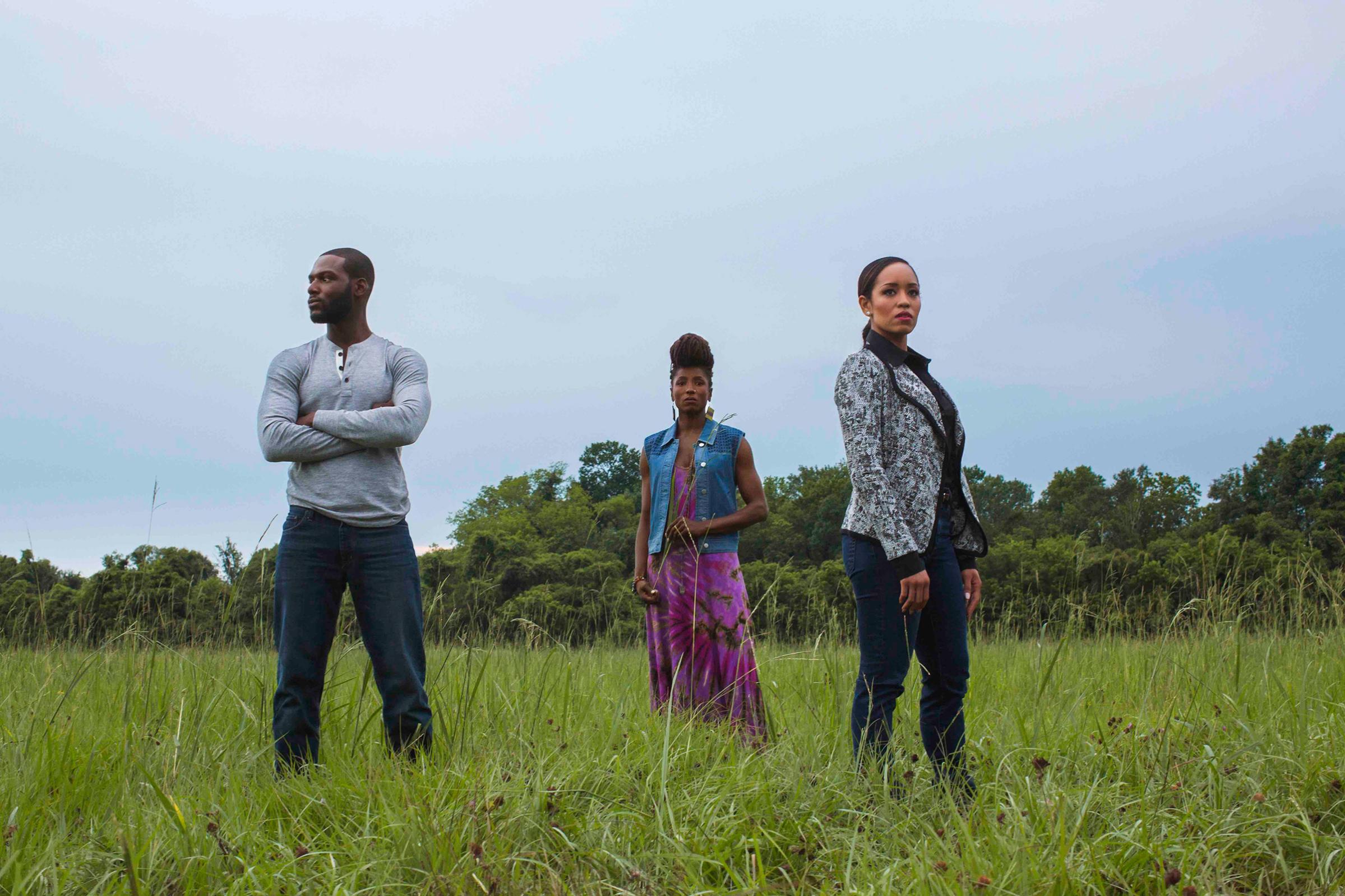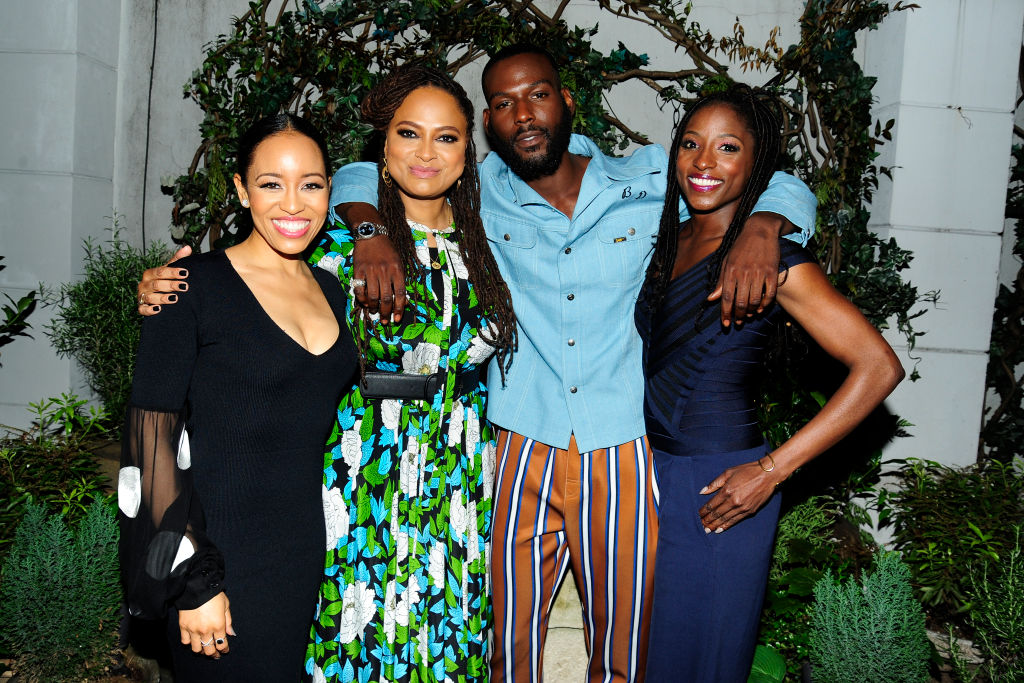
The New Orleans set of Queen Sugar is buzzing with energy. It’s a relentlessly humid July day, and creator Ava DuVernay has returned to direct the series finale, which will air on Nov. 29, her first time helming an episode since its debut season, in 2016. DuVernay yells “Cut!” and rises from her chair, moving nimbly through the immaculately decorated living room of the show’s central character, Nova Bordelon (Rutina Wesley). DuVernay converses with camera operators and grips. She positions props to her liking. Her light but authoritative touch is on everything from scripts to wardrobe. She finally stops in front of the couch where Wesley lies under a thick blanket, adjusting it to ensure that the actor’s striking face isn’t obscured. They talk briefly about the scene. “We have an unspoken language,” Wesley tells me later. “Ava would speak to me through her pen, and then I would respond with my work.”
To watch DuVernay in action is to understand her creative process on a deeper level. Later she will tell me that she likes to film many takes of the same scene—“collecting my toys,” she calls it—so she has options in the editing room. She’s looking for emotive glances, subtle shifts in posture, the “gentle moments” that characterize Queen Sugar’s intimate storytelling. The Juilliard-trained Wesley is a master at this kind of emotional dexterity. She begins delivering the last words Nova Bordelon will ever utter. As the crew looks on, they seem to carry the bittersweet knowledge that the series into which they’ve poured so much is coming to an end after seven seasons.
Queen Sugar, arguably the longest-running African American family drama in history, has revolutionized TV. DuVernay and executive producer Oprah Winfrey charted a path for the show on OWN. It averaged more than a million weekly viewers in its first seasons—a major feat for a boutique cable network during the rise of streaming. African American viewers were hungry for a show that authentically depicted the lives of everyday Black people, that didn’t pathologize them or shroud them under a veil of respectability. The nuanced characters, lighting that celebrated the beauty of melanated skin, and soulful soundtrack galvanized a legion of Twitter fans who shared their commentary using #gimmiesugar. DuVernay and members of the cast and crew joined in, mirroring the type of community the show itself exemplified.
Read more: Ava DuVernay on What Gives Her Hope
Onscreen, the show advanced story lines about labor exploitation and the carceral state; transgender rights and the Movement for Black Lives. Behind the camera, it has been shaped by DuVernay’s inclusive politics of collaboration. She’s created opportunities for hundreds of talented actors, directors, line producers, prop masters, and costume designers, many of them New Orleans natives. Her commitment to partnering with those who’ve historically been marginalized in the industry places her and Winfrey at the vanguard alongside other Black creatives fighting for lasting change in Hollywood.

Queen Sugar the show would not exist without Queen Sugar the novel, and Queen Sugar the novel might never have been put in front of DuVernay if not for Winfrey. And not just casually put in front of her: Winfrey was so determined for DuVernay to read Natalie Baszile’s 2014 book, about a woman who inherits an 800-acre family farm in rural Louisiana, that during the director’s stay at Winfrey’s Maui estate in 2014, the host placed copies of Queen Sugar in Ava’s room, at the kitchen table, on the porch. DuVernay finally devoured it, so inspired that she wrote the treatment for the television show on the flight back to Los Angeles.
When it came time to write the pilot, Winfrey encouraged DuVernay to let the book go and filter what she’d read through her own imagination and her own family’s Southern roots. Taking this note, DuVernay conjured magic, creating the Nova Bordelon character, who didn’t exist in the book but became the show’s spiritual anchor. She fleshed out the fictional milieu of St. Josephine, La. And while this worldmaking allowed DuVernay to tackle salient social issues, at its core, Queen Sugar is a show about the power and possibilities of Black love: familial love, romantic love, and love for one’s community. There is the love story between Darla and Ralph Angel, who piece their lives together after battles with addiction and incarceration. Mature Black women appreciated the May-December romance between Violet Bordelon and her devoted husband Hollywood Desonier. Seeing Nova bring her bourgeois sister Charley and nephew Micah deeper into the Movement for Black Lives acknowledged the rich history of grassroots community activism across the South.
More from TIME
Winfrey unilaterally greenlighted the show for OWN. “I didn’t give it any thought,” she told me over the phone. “All of the great things I’ve ever done have come out of feeling and instinct.” Winfrey had launched OWN in 2011—a peak moment in TV’s golden era—to break new ground and support new talent. This golden age may have been in full swing ever since Tony Soprano took a seat in his therapist’s office, but the vestiges of Jim Crow segregation in the industry made it difficult for Black showrunners and executives to seize the moment. By the 2010s, some had busted through, producing shows across genre—Scandal, Being Mary Jane, Empire, Power, Black-ish—about multi-faceted African American characters who defied stereotypes. Shonda Rhimes, Issa Rae, Donald Glover, Lena Waithe, Kenya Barris, Lee Daniels, Courtney A. Kemp, Mara Brock Akil became voices of the so-called Black TV renaissance.
When Winfrey bet on DuVernay, she was putting her money on an untested creator who had directed only one episode of TV (for Scandal). This was after indie films had established her reputation as a bold storyteller with cinematic vision, but before Oscar nominations for Selma and an Emmy for 13th, before she was a household name. It is virtually unheard-of for a first-time creator to have a project greenlighted from a pilot script, and even rarer that the decision is made without a committee of high-level studio executives. But Winfrey had amassed considerable power, and she leveraged it to open the door for DuVernay.

DuVernay vowed to keep that door open for others. She proposed to Winfrey that they hire only women to direct the show. That one decision established a creative ethos for Queen Sugar while helping transform industry hiring practices. “I give all, all praise to [Ava],” Winfrey says. At the time, women directors—especially Black women and other women of color—who wanted to break into episodic television were stymied by retrograde industry norms that granted men the most prestigious jobs. This created a maddening paradox: women couldn’t get hired if they didn’t have the experience, and they couldn’t gain the experience without getting hired.
Of the 42 women recruited to direct Queen Sugar, 39 had never directed an episodic series in the U.S. “Ava handpicked all of us,” says Shaz Bennett, who has directed, written, and served as the Season 7 showrunner. “From the beginning, [Ava] would say, ‘Watch the show, and get the feeling of it, but I want you to bring your skill to this.’” Each director’s creative bent brought an emotional texture that enhanced what Bennett describes as Queen Sugar’s “beautiful feminine gaze.”
Read more: 24 Essential Works of Black Cinema Recommended by Black Directors
The show counts among its alumnae Victoria Mahoney, Aurora Guerrero, Amanda Marsalis, and DeMane Davis, who’ve all gone on to have stellar careers in TV—Mahoney went on to direct for Lovecraft Country and The Morning Show, Marsalis for Westworld and Ozark—and their successes reflect those of their peers. Pioneering indie filmmaker Julie Dash, who had never directed a scripted series, had her TV career jump-started. “It’s changed the way people look at women directors,” says Bennett. “Now if you don’t have women directors on your roster, it’s like, ‘You haven’t even been looking.’” DuVernay is proud to see the women and people of color who’ve made up Queen Sugar’s production team parlay that big break into other high-profile opportunities. But she told me what matters most to her is being intentional about leveling the playing field.
“Queen Sugar has been my second job for six years,” DuVernay told me when I visited the set. She’s juggled Sugar while directing other projects, including A Wrinkle in Time and When They See Us, while also distributing films by underrepresented directors through her independent production company, ARRAY Filmworks. Now Queen Sugar is ending on her terms. “It feels complete,” she says. I looked around the set at Nova’s bungalow, Aunt Vi’s diner, and the Bordelons’ farmhouse, and realized I was standing in the brick-and-mortar manifestation of DuVernay’s imagination. She had dreamed this world and collaborated with people who could help her make it a reality. More than anything, I could feel the love between cast and crew, and the palpable spirit of creative excellence that captivated viewers week after week. This is Queen Sugar’s greatest legacy.
More Must-Reads from TIME
- Cybersecurity Experts Are Sounding the Alarm on DOGE
- Meet the 2025 Women of the Year
- The Harsh Truth About Disability Inclusion
- Why Do More Young Adults Have Cancer?
- Colman Domingo Leads With Radical Love
- How to Get Better at Doing Things Alone
- Michelle Zauner Stares Down the Darkness
Contact us at letters@time.com